1910’s – in 1916 the first woman was elected in the House of Representatives. Her name was Jeannette Rankin of Montana
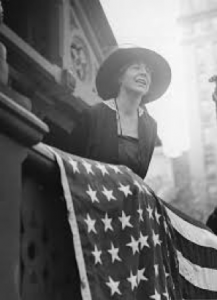
[ Source: Times Magazine]
1920’s – Known as the Roaring 20’s – Known for the “flapper” look where women cut their hair into a blunt bob, wore shorter skirts, and became more unladylike and free. The 19th amendment was passed and allowed woman to finally vote.
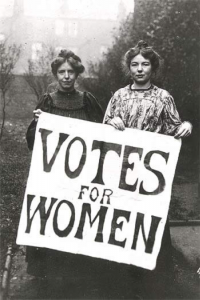
[Source: TES.com}
During the 1920s, some freedoms were expanded while others were curtailed. The 18th Amendment to the Constitution, ratified in 1919, had banned the manufacture and sale of “intoxicating liquors,” and at 12 A.M. on January 16, 1920, the federal Volstead Act closed every tavern, bar and saloon in the United States.
1930’s- The Great Depression put a damper on all the prosperous movements of the 1920’s at the beginning of the 30’s.
During the Depression,most people did not have much money to spare. However, most people did have radios–and listening to the radio was free. The most popular broadcasts were those that distracted listeners from their everyday struggles: comedy programs like Amos ‘n’ Andy, soap operas and sporting events.
By the end of the 1930s, the New Deal had come to an end. Growing Congressional opposition made it difficult for President Roosevelt to introduce new programs. At the same time, as the threat of war loomed on the horizon, the president turned his attention away from domestic politics.
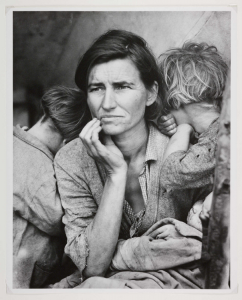
[By Dorothea Lange ]
1940’s- Because of World War 2 woman played a new role in America: Between 1940 and 1945, the female percentage of the U.S. workforce increased from 27 percent to nearly 37 percent, and by 1945 nearly one out of every four married women worked outside the home.
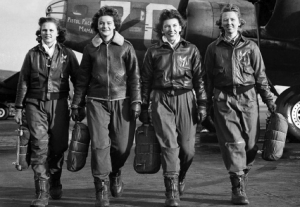
[Source: Khanacademy.com]
1950’s- “America at this moment,” said the former British Prime Minister Winston Churchill in 1945, “stands at the summit of the world.” During the 1950s, it was easy to see what Churchill meant. The United States was the world’s strongest military power. Its economy was booming, and the fruits of this prosperity–new cars, suburban houses and other consumer goods–were available to more people than ever before.
The Post War Boom
The booms of the 1950s had a particularly confining effect on many American women. Advice books and magazine articles (“Don’t Be Afraid to Marry Young,” “Cooking To Me Is Poetry,” “Femininity Begins At Home”) urged women to leave the workforce and embrace their roles as wives and mothers. The idea that a woman’s most important job was to bear and rear children was hardly a new one, but it began to generate a great deal of dissatisfaction among women who yearned for a more fulfilling life.
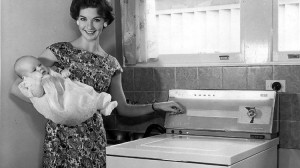
[Source: Emaze.com]
1960’s – On January 20, 1961, the handsome and charismatic John F. Kennedy became president of the United States. His confidence that, as one historian put it, “the government possessed big answers to big problems” seemed to set the tone for the rest of the decade.
The struggle for civil rights had defined the ‘60s ever since four black students sat down at a whites-only lunch counter in Greensboro, North Carolina, in February 1960 and refused to leave. Their movement spread: Hundreds of demonstrators went back to that lunch counter every day, and tens of thousands clogged segregated restaurants and shops across the upper South.
President Johnson pushed a Civil Rights Act through Congress that prohibited discrimination in public places, gave the Justice Department permission to sue states that discriminated against women and minorities and promised equal opportunities in the workplace to all.
At the same time, young women who had read The Feminine Mystique, celebrated the passage of the 1963 Equal Pay Act and joined the moderate National Organization for Women were also increasingly annoyed with the slow progress of reform. They too became more militant.
The counterculture also seemed to grow more outlandish as the decade wore on. Some young people “dropped out” of political life altogether. These “hippies” grew their hair long and practiced “free love.” Some moved to communes, away from the turbulence that had come to define everyday life in the 1960s.
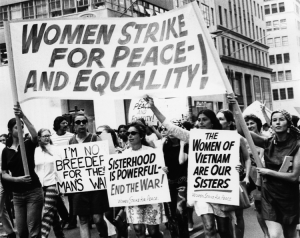
[Source: Time Magazine]
1970’s- Women, African Americans, Native Americans, gays and lesbians and other marginalized people continued their fight for equality, and many Americans joined the protest against the ongoing war in Vietnam.
On January 22, 1973, the U.S. Supreme Court handed down its landmark decision in the case of Roe v. Wade, which recognized that the constitutional right to privacy extends to a woman’s right to make her own personal medical decisions — including the decision to have an abortion without interference from politicians
In 1972, after years of campaigning by feminists, Congress approved the Equal Rights Amendment (ERA) to the Constitution, which reads: “Equality of rights under the law shall not be denied or abridged by the United States or by any state on account of sex.”
1980’s- September 21, 1981 – Sandra Day O’Connor is approved unanimously, 99-0, by the United States Senate to become the first female Supreme Court associate justice in history.
June 18, 1983 – Astronaut Sally Ride becomes the first American woman to travel into space.

[Source: New York Times]
1990’s – 1994: The Violence Against Women Act funds services for victims of rape and domestic violence, allows women to seek civil rights remedies for gender-related crimes, and provides training to increase police and court officials’ sensitivity and a national 24-hour hot line for battered women. The National Organization for Women called it “the greatest breakthrough in civil rights for women in nearly two decades.”

[Souce: CNN]
2000’s-
2005 Hillary Clinton becomes the first, First Lady to be elected to public office as a U.S. Senator from New York. Condoleezza Rice becomes the first black female Secretary of State.
2007 Nancy Pelosi becomes the first female speaker of the House.
2009 Sonia Sotomayor is nominated as the 111th U.S. Supreme Court Justice. Sotomayor becomes the first Hispanic American and the third woman to serve.
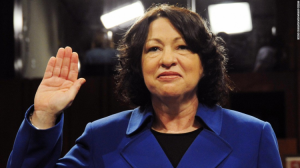
[Source: CNN]
2017– The Women’s march
2017/18- “The Me Too” movement
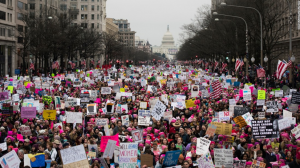
[Source: CNN]


